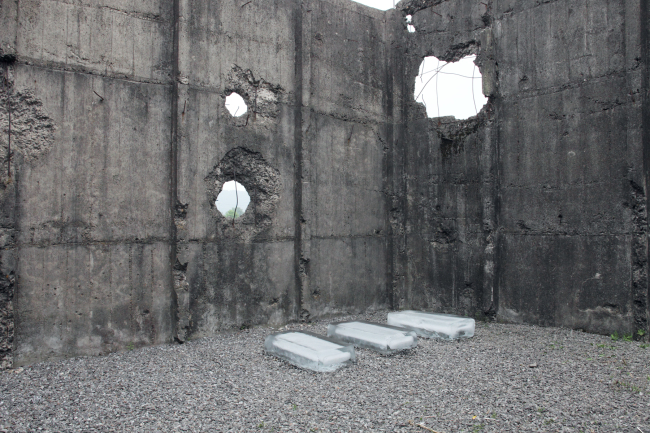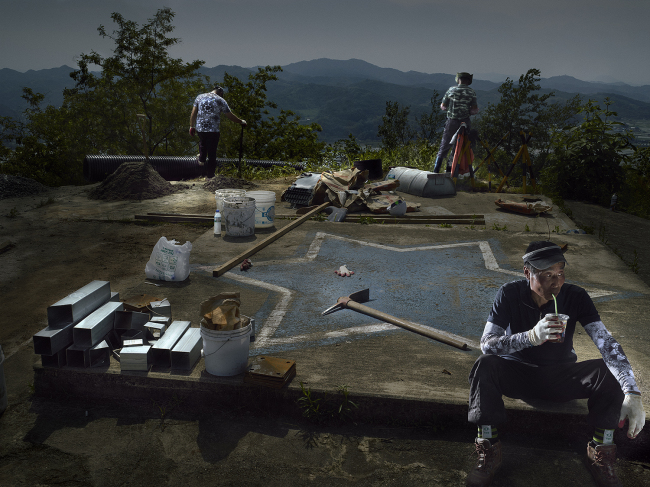Art Sonje Center presents its second DMZ art project in Cheorwon
 A concept image showing the site for performance work “What Cannot be is What” by Paul Kajander. (Art Sonje Center)
A concept image showing the site for performance work “What Cannot be is What” by Paul Kajander. (Art Sonje Center)
Irish artist Jesse Jones holds a deck of tarot cards and asks audience members to put their hands on the card deck and think of a question related to the relationship between South and North Korea.
She asks the audience again to speak about their questions. A member of the audience raises a hand and asks, “Will there be any changes in the Kim Jong-un regime?”
A tarot card reader picks six random cards, telling the past, present and future and collective unconsciousness.
According to the reading, Kim Jong-un’s regime has maintained a stable social order and people are satisfied with it. Now the regime is stepping up efforts to solidify its position, but people are somewhat disappointed and afraid of their leader because Kim Jong-un is authoritarian and very driven to see things to the end.
 “Memorial to Memorial,” by Yun Su-yeon. (Art Sonje Center)
“Memorial to Memorial,” by Yun Su-yeon. (Art Sonje Center)
For a while, the regime will maintain stability, but in the future, it will have to face a “decision” that will be critical in maintaining the regime, the reading said.
More questions followed, surprising the audience with plausible answers.
The performance was held on Monday as a pre-event for an art project taking place near the heavily fortified Demilitarized Zone in Cheorwon, Gangwon Province, which takes up a third of the 250-kilometer-long DMZ separating the two Koreas.
The “2013 Real DMZ Project: Borderline,” organized by Art Sonje Center and its exhibition planning group Samuso, engages with various sites along the DMZ tour route. Thirteen artists created paintings, photographs, videos and installation works at an observatory, the last station remaining on the railway that used to have service between Seoul and Wonsan, now in North Korea, and the remains of buildings that survived the Korean War.
“The project explores the historical, political and social context of the DMZ and its relevance to the lives of modern Koreans,” Kim Sun-jung, artistic director and curator of the art project.
“It offers an opportunity to reflect upon the implications of these borders, through the varying ways in which connections are made between the past, the present, and the future in the DMZ,” she said.
Canadian artist Paul Kajander goes back to the Japanese occupation in Korea. His performance with local children takes place in an ice storage that used to be run by a Japanese owner. It is also one of the few buildings in Cheorwon that survived the heavy bombing during the Korean War.
“We have these walls indicating the history of conflicts: there are bullet, bombardment holes that are eroding naturally. In the performance, students are using the space to engage with history with obvious signifiers and clues,” said Kajander during the guided tour on Monday.
The children are asked to read a text prepared by the artist. The performance using blocks of ice and potatoes, reminders of the old function of the storage, is documented in photographs and exhibited at Woljeong-ri Station, the final station on the southern half of the railway which once connected Seoul and northern cities.
Sites that are not in use today are open for an exhibition tour. In the open space in front of the unused Peace and Culture Plaza, sits a large wooden panel with the title of the novel “One Hundred Years of Solitude,” written by Malaysian artist Heman Chong, and large basalt rocks artist Koo Jeong A borrowed from residents in Sayori village in Cheorwon.
Cheorwon-based artist Kim Sun-kyong’s oil paintings of the local landscape are hung on the wall of the second floor of the Cheorwon Peace Observatory.
“This area has always been tense and under tight censorship. And the art project throws out new questions to the residents (to think about the meaning of the place in their lives). I think that’s what makes the project meaningful. After all, the purpose of art is for human liberation,” said Yi Jong-ho, architect and professor of the department of architecture at the Korea National University of Arts, who was one of the advisors for the project.
More artworks are on exhibit at Art Sonje Center in Jongno, Seoul.
The Art Sonje Center runs the exhibition tour every Saturday from Aug. 3 to Sept. 21. The tour departing from Seoul costs 30,000 won per person, including entrance fee. Lunch is not included. For more information and reservations, visit www.realdmz.org.
By Lee Woo-young (wylee@heraldcorp.com)
http://www.koreaherald.com/view.php?ud=20130725000767